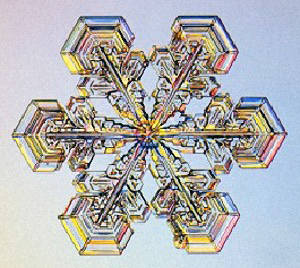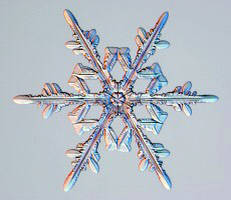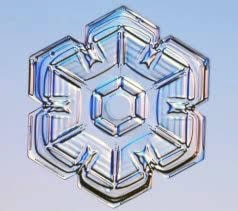Roseanne Van Ee
For the Morning Star
Of all the crystals on Earth, snowflakes are my favourite.
Snow forms when water vapours crystallize in subfreezing clouds high up in the sky. A snowflake is a single ice crystal that has developed around a microscopic nuclei particle of dust, ash, pollen, sea salt, another organic or mineral microorganism, or stuff from outer space. Snowflakes progressively grow into kaleidoscopic hexagonal (six-sided) crystals as they tumble and drift down to Earth. On their downward journey temperatures may change, they may be buffeted by winds, bump into other flakes and pass through clouds with different temperatures and moisture. Some take hours to reach the ground. Many never get there but melt or evaporate on their way down.
The complex range of conditions a snowflake slips through as it descends designs the snowflake’s pattern. Why snowflakes grow flat rather than three-dimensionally is a mystery. Each snowflake has its own history, making each one different. No two are alike; like people perhaps.
In 1885, Wilson Bentley of Vermont was the first person to photograph snowflakes with a camera-microscope. In 1931 he published an amazing book with his best photos called Snow Crystals. Kenneth Libbrecht now photographs snowflakes with coloured lights and has published a number of books. He posts gorgeous, intricate photos on www.snowcrystals.com. Take a look.
When you breathe out on a cold day, that’s a small water vapour cloud.
Want to make snow? Quickly toss a spray of hot water from a cup into the air outside on a very cold day (-25 C or colder).
Snowflakes aren’t white; they’re clear. Numerous, multifaceted, minute snowflake crystals act like prisms reflecting light that appears white. Clement C. Moore’s infamous poem, A Visit From St. Nicholas, magically describes reflecting snow; “The moon on the breast of the newly fallen snow gave a lustre of mid-day to objects below.”
Light from the sun is reflected off the full moon onto the snow which reflects through the dark night to light up the scenery. Go out on a snowy moonlit night to experience this and look around. It’s spectacular.
Cold (-5 C and lower), fresh snow piles often contain up to 95 per cent air. Over time, wind, air pressure, extra weight, moisture and temperature metamorphises the snowflakes into pieces, graupel (corn snow), and eventually back into water. Or they may vaporize into the air. Mountaineers study the metamorphic sequence and layers of snow, and its characteristics to predict avalanches. Glaciers are ancient deep layers of accumulated snow turned into ice lower down. When you make a snowball, you’re punching out the air. Your hands and the crystals’ friction creates warmth and moisture. That’s why the big snowball at the bottom of a snowman is so heavy.
Snow is part of the great continual water cycle. Snowflakes are my favourite stage (could you guess?). To paraphrase Bentley; “Of all the forms of water, the tiny six-pointed crystals of ice called snow…are incomparably the most beautiful and varied.” Charlie English writes in The Snow Tourist; “Our lives, like those of snow crystals, are transient moments within a succession of other transiences. We resemble those crystals in another way, too. Like them, we are made mostly of water. When we die, the water in us will find its way to the sea, where in time it will be lifted up by the sun, to fall again as snow.”
I’ll write more about snow later on. So, go play in the snow. It’s truly a winter wonderland. If there’s not enough snow in the valley, head up to Sovereign or Silver Star. There are lots there.
Roseanne enthusiastically shares her knowledge of the outdoors to help readers experience and enjoy nature. Discover exciting and adventurous natural events, best trails, and wild places. Follow her on Facebook for more.


